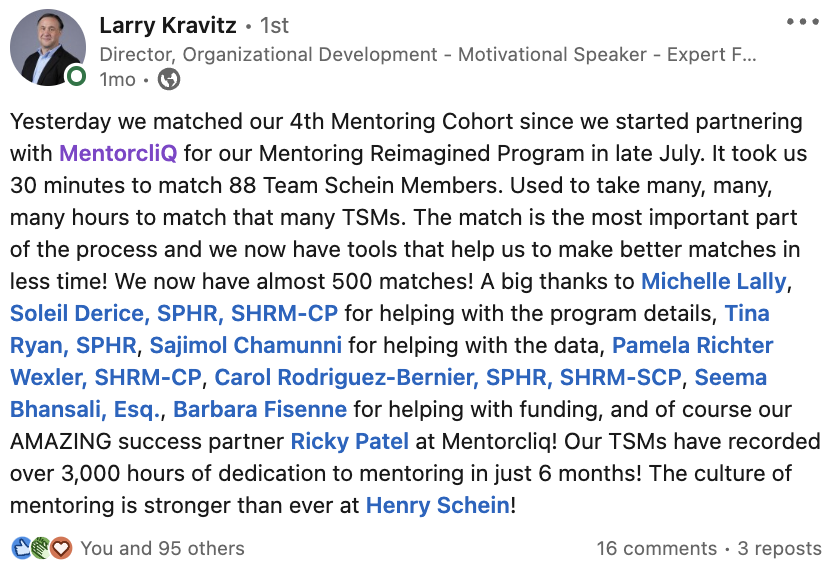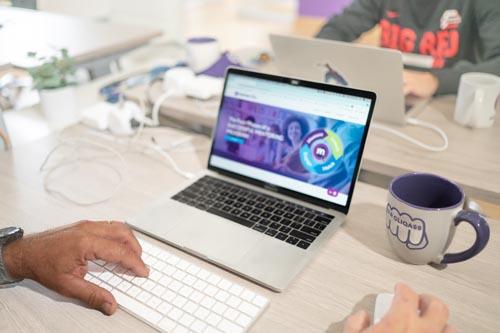Many companies understand the need to increase employee engagement, but many also struggle to adequately define what that means in practice. Is employee engagement all about active and ongoing discussions? Talent development opportunities? Networking events? The answer is usually, “yes, and…” There’s seemingly no end to what engagement can be. But making it work properly starts with creative solutions that can offer as many types of engagement needs as possible. That’s where mentoring and employee engagement software intersect.
Mentoring programs are like a multi-tool for employee engagement. And with software, mentoring (and all of the engagement types you fit within it) becomes scalable, trackable, and distinctly more visible across your organization. Here, we’ll help you understand three key employee engagement benefits offered through mentoring software.
1. Mentoring Helps Decrease Absenteeism
You’re probably familiar with the phrase, “Showing up is half the battle.” While not entirely scientific, it’s one of those universal truths that applies to most things in life, especially employee engagement. Engaged employees show up to work; disengaged employees find every possible excuse in the book to avoid work as much as possible.
Consequently, Gallup ran a meta-analysis that found there was an 81% difference in absenteeism between companies with the highest levels of employee engagement and the lowest levels of it.
It’s simple: employees who aren’t engaged don’t want to come to work. This isn’t to suggest that they’re lazy or incompetent. Instead, it’s a reflection of how important they feel they are to the company, how little connection they feel to their teams, and how much growth potential they see in their role. Disengaged employees who aren’t showing up have one foot out the door.
This underscores one of the key benefits of using mentoring software to increase employee engagement. Mentoring software allows you to create best-fit matches for mentoring programs more quickly and effectively. Reducing the time and effort employees require to get enrolled in a mentoring program increases the likelihood that they’ll join, boosting your mentoring program participation rates.
And if you offer a larger variety of mentoring programs, you’re far more likely to get higher levels of participation.
Those employees who feel disconnected from their roles, who desire skill development, or who want to build their professional networks will find easier access to all of these thanks to the features available through the mentoring platform.
2. Mentoring-Based Employee Engagement Increases Retention
Almost everyone is struggling with employee retention right now. And while it may not feel like it, U.S. unemployment rates are sitting at 50-year lows as of this time of writing.
Source: tradingeconomics.com
While many people aren’t working in the roles they’d most prefer, and it’s taking a bit longer for companies who are hiring to find their ideal candidates, the reality is that we’re in an economic environment that’s effectively similar to what’s called “full employment.” Most people who can and do want to work are working. Yet many companies are still hiring. And that means it’s far easier for companies to lose their best employees right now to competitors.
So how does mentoring with software help? It allows companies to offer more and a greater variety of people-centric engagement options. And it helps boost employee retention.
In our 2023 Mentoring Impact Report, we found that, on average, companies with mentoring programs increased their number of employees during the Great Resignation that emerged immediately after the pandemic. The average company without visible mentoring programs lost around 4,000 employees.
Mentoring alone was likely not the only strategy those companies were using to improve employee engagement. But comes down to whether a company has a culture of engagement that includes more effective strategies. Quite likely, all of those companies are using software of some kind to supplement their mentoring strategy, especially if their mentoring programs are available to thousands of employees at once.
Across our clients, mentoring software reduces by an average of around 50%, leading to millions of dollars in savings per year on retention costs for some of the largest and most profitable companies in the world. Book a demo today to see for yourself!
3. Software-Backed Engagement Increases Profitability
High levels of employee disengagement and high turnover are extremely costly to businesses. In fact, Gallup called employee disengagement the world’s “7.8 Trillion Dollar Problem.” To say that’s an expensive problem is an understatement. Employee disengagement, collectively, costs companies an amount of money that’s equivalent to the 2017 gross domestic product (GDP) of Canada, South Korea, Australia, Spain, Mexico, and Indonesia combined.
That’s about 8% of the world’s GDP in 2021. That’s a lot of money.
It’s easy to ignore that on the macro level. After all, that’s cumulative. But on a micro level, a disengaged employee costs a company about 18% of that employee’s salary, while 18% of workers now self-report as being “actively disengaged.”
That means if you have a business unit with 1,000 employees, 180 of them may be actively engaged. And to get a bit mathy on you: 180 x 18%($60,000)) = $1,944,000. Having just 180 employees actively disengaged at your company can cost nearly $2 million in lost productivity.
If you’re an HR leader, you may want to run some of these numbers yourself. Use our calculator below to toy with some of your internal numbers (don’t worry; this tool won’t save your data!):
Enter the following values to calculate the Cost of Disengagement:
If those numbers don’t look good to you, there’s some light at the end of the tunnel here. Imagine having this in reverse. What if your company saved on productivity costs or, better yet, increased productivity? That number you got would go straight into your company’s profits.
That’s a huge win and one that’s an ultimate positive benefit for mentoring with software.
Why employee engagement software? Two reasons (out of many):
- Mentoring software allows you to scale programs more effectively, increasing the number of people you can enroll in programs.
- Mentoring software uses advanced matching algorithms that remove human biases, creating best-fit matches that lead to better relationship fit and, therefore, better mentoring program results.

That’s precisely what MentorcliQ client Henry Schein discovered. By re-launching its mentoring programs and switching from manual mentoring to a mentoring software approach, Henry Schein reduced the time it spent matching participants by 99%. That dramatically increased the number of participants it could enroll in its programs. More mentoring participants = more widespread employee engagement. And that equals more productivity, lower turnover, most cost savings, and increased profit margins.
Employee Engagement Trends Are Changing the Game for Companies
Why is this happening? Part of the problem is that employees aren’t being challenged or given opportunities to learn new skills or grow beyond their current position. This leads to a feeling of stagnation and boredom. According to Udemy’s 2016 report on workplace boredom, employees who are bored are twice as likely to leave a job, thereby costing the company thousands in lost revenue, institutional and industry knowledge, and all of the connections that the employee made while on staff.
The good news is that organizations have the power to redirect this trend. One of the most effective methods for creating a feeling of connectedness within an organization is targeted and impactful learning relationships, such as mentoring. The Association for Talent Development has stated one of the top benefits to organizations with mentoring programs is employee engagement.
Mentoring programs provide opportunities for mentees to learn new skills, experience challenging projects, learn the overall company vision and increase the number and strength of their business connections.
While this sounds like a simple fix, organizations need to be mindful and intentional in setting up their mentoring programs because implementing a poorly designed and supported program can be worse than having no program at all.
Some of the pitfalls can be ineffective or toxic mentoring matches, no support for the mentoring participants, lack of training for the mentors, no support from organizational leadership, and no supporting data on program efficacy.
To ensure that your mentoring program is sustainable, scalable, and evolves into a long-term solution to increase employee engagement, the utilization of mentoring software will be key. It can address most of the pitfalls mentioned above. This allows the learning needs of employees to develop with training and certifications, supported by mentoring software.
How do you manage active mentoring programs? Many organizations manually manage their mentoring programs, usually using complicated Excel spreadsheets, overwhelming amounts of email, or sticky notes. This may be efficient for a small group of 20 participants, but what happens when that number increases?
How Much Time Saved by Mentoring with Software?
Ultimately, the best mentoring programs are designed to be scalable so that the results increase over time and the mentoring program’s management efficiency (# of hours needed) decreases. Larger programs that do not utilize software may cause lower engagement with the program participants, inaccurate employee engagement data for the leadership team, and ultimately, low participant numbers and overall dissatisfaction with the program.
Having the ability to manage mentoring programs with a high participation rate, engaged mentoring partners, along with positive outcomes and accurate employee engagement numbers, takes the work of a mentoring software solution.
It is safe to say the majority of companies are well past the days of using Excel spreadsheets or even pen and paper to track inventory, sales trends, production, etc. They have all turned to some type of ERP system or CRM system to help improve efficiency, increase productivity, and provide accurate numbers.
Many of these companies see a great return on their business software solution, so it only makes sense to make that same investment with a mentoring program. One of our customers (Christopher N.) states:
“Our ability to match mentors and mentees on a larger scale has been excellent. The ability to track success and gauge feedback through the MentorcliQ tool has also enabled our organization to keep a pulse on how the program is advancing.”
MentorcliQ engages and supports employees throughout the entire mentoring relationship. From the easy 5-minute enrollment, award-winning SMART matching algorithm, readily accessible support, and resources to an easy way to track mentoring progress, this mentoring software can provide accurate employee engagement results.
From an employee engagement standpoint, a company that offers a mentoring program says a lot about that company. It shows they care about their employees and want their employees to grow and flourish.
Better yet, a company that offers mentoring programs and utilizes mentoring software to help guide and support those programs truly displays its investment in its employees because a company will not invest in something without a good ROI.
So, for companies looking to increase employee engagement, the action should be to not only offer mentoring within the organization but show your employees that you are genuinely interested in their career development. Offering mentoring software will help you and the participants track progress and reflect on goals met. This is a great recipe for increasing employee engagement.
Are You Ready to Boost Engagement with a Mentoring Platform?
Do you want to see how mentoring programs powered by mentoring software can impact and improve the engagement of your employees? Connect with MentorcliQ to learn more.




